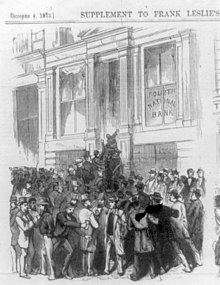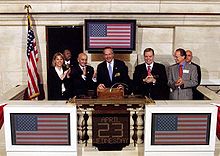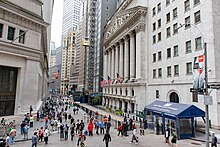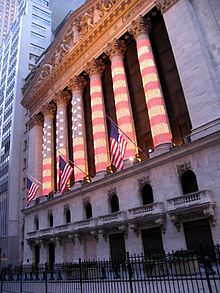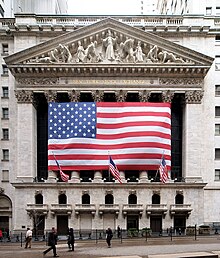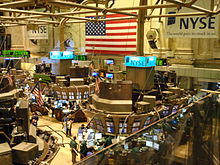New York Stock Exchange
The New York Stock Exchange ( NYSE ) is the largest stock exchange in the world and is part of the Intercontinental Exchange . The NYSE is also known as " Wall Street " because it is located on the street of the same name in New York , USA . Trading hours on the NYSE are 9:30 am to 4:00 pm local time EST (3:30 pm to 10:00 pm CET) on business days.
The market capitalization of more than 2200 on the New York Stock Exchange listed companies was in June 2018 28,528 billion US dollars , making it the world's largest stock exchange.
history
1790 to 1800
In 1790 the US government issued government bonds for around 80 million US dollars to finance the debt from the American Revolutionary War (1775–1783). The public trade in these war bonds marked the beginning of the US securities market . On March 10, 1792, the land speculator William Duer went bankrupt , putting the Bank of New York (now Bank of New York Mellon ), the oldest bank in the United States, in trouble. It was founded in 1784 by Alexander Hamilton (1757-1804) and William Duer. Hamilton bought the bank's paper back to stabilize the price. He saved the bank from bankruptcy . The share was the first company to trade on Wall Street in 1792.
The foundation stone for the New York Stock Exchange was laid by 24 brokers who signed the Buttonwood Agreement on May 17, 1792 at 68 Wall Street . In it, the traders undertook to charge customers at least a quarter of a percent commission for buying and selling securities and to give each other preference when trading stocks and bonds. Trade should take place in US dollars , which the US Coin Act of 1792 made the official currency unit. The name of the agreement is derived from the Buttonwood tree under which the agreement was signed.
Stock trading grew rapidly in the years that followed. In 1792, just five stocks were traded in New York: the stocks of two banks and three government bonds issued in 1790. As early as 1793, the brokers met in the nearby "Tontine Coffee House" for daily trading. The market worked in such a way that the various securities were called out at two meetings in the morning and afternoon and the traders then submitted their bids for them.
1801 to 1850
On March 8, 1817, for the first time, stock exchange regulations were established and a formal organization was established: The New York Stock & Exchange Board (NYS & EB), which took up residence on Wall Street. In the same year, the trading procedures were also redefined. A so-called call market was created . The rules, printed by the Philadelphia Stock Exchange, governed the statutes. After three years of testing, however, these were revised and on February 21, 1820 a new statute was adopted.
A railway company was listed for the first time in 1830: Mohawk & Hudson. Other companies soon followed, and railroad stocks became the first sort of boom stock that shaped trading for the rest of the century.
March 16, 1830 went down in Wall Street's annals as the day with the lowest sales. 31 of the 80 million shares listed at the time were traded that day. But there were also days like March 14th and 17th, 1821 and January 8th, 1829, when, according to the Journal of Commerce , no trading took place despite the open stock exchange , and September 19, 1828, when a single piece of a six percent government bond was traded has been.
On December 16 and 17, 1835, a major fire destroyed over 700 buildings in New York, and Wall Street was not spared either. However, other places were quickly found where trade could continue. A year later, stock trading was banned on the streets of New York. Until then, it was quite common to be offered stocks on the street.
The panic of 1837 was caused by a speculative fever. The bubble burst in New York on May 10, 1837, when all banks stopped converting paper money to gold and silver. The trigger of the crisis was, among other things, the economic policy of US President Andrew Jackson , including the "Specie Circular" (currency circular), which only allowed gold or silver as a means of payment for land sales by the US government. It restricted the printing of paper money from individual state banks and led to a currency shortage that contributed to the outbreak of panic. This was followed by six years of economic depression, the permanent insolvency of many banks and record unemployment.
With the introduction of the telegraph in 1844, traders and investors outside of New York were able to participate in trading for the first time.
1851 to 1900
New York experienced a stock market crash on August 24, 1857, when the collapse of the Ohio Life Insurance & Trust Company triggered mass hysteria and panic selling. The subsequent economic crisis of 1857 spread rapidly across the world. The stock exchange was given its current name "New York Stock Exchange" (NYSE) on January 29, 1863.
With the completion of the first permanently operated transatlantic telephone cable in 1866, communication between New York and London accelerated. On November 15, 1867, stock market tickers were introduced for the first time . Edward A. Calahan's invention revolutionized messaging on the stock exchange. Investors now had the opportunity to get daily prices from anywhere. On May 8, 1869, the NYSE merged with the Open Board of Brokers .
On September 24, 1869, gold speculation on the NYSE caused the first " Black Friday ". Attempts by speculators James Fisk and Jay Gould to get the gold market under their control failed and led to the market collapse. By September 20, 1869, Fisk and Gould had brought New York City's gold reserves under their control to such an extent that they could soar the price. Gold demand was halted on September 24th when the government released gold reserves for free trade. A short-term financial crisis in the USA was the result.
The " panic of 1873 " led to a severe financial collapse on Black Friday, September 19 of that year, which triggered a subsequent panic. The cause was the bankruptcy of the bank "Jay Cooke & Company". This development was preceded by speculation with railroad companies and land. To halt sales, for the first time in NYSE history, trading was suspended for ten days from September 20-29, 1873.
The banking crisis of 1884 began with the bankruptcy of the "Marine National Bank" on May 6th of that year. With almost $ 17 million in liabilities , the bank had hardly any assets to speak of. On May 13, it became known that the president of the "Second National Bank" had embezzled securities worth three million US dollars, the following day the "Metropolitan Bank" went bankrupt. Between May 12 and May 14, the NYSE suffered massive price losses. A calming down only came when the "Associated Banks" issued six percent loan notes on the afternoon of May 14, 1884 and shortly afterwards large sums of capital flowed into the money market, which the high interest rate had attracted, while the low prices invested investors in larger purchases of securities caused.
Investors quickly lost track of things during the banking crisis of May 1884, and Charles Dow reacted to market events. On July 3, 1884, he published the first US stock index , the Dow Jones Average , in the Customers' Afternoon Letter issued by Dow Jones & Company . It initially consisted of eleven values. This index should offer investors an understandable and representative composition of what is happening on the stock exchange. In 1885 it became an index based on 14 stocks. It was characteristic of the time that twelve stocks were railroad stocks and only two were industrial stocks.
The "Panic of 1893" began on 20 February of the year, when the Philadelphia and Reading Railroad in receivership was transferred. On March 4, US gold reserves shrank to an all-time low of $ 100 million. Investors were concerned that the US dollar would soon depreciate. After numerous companies went bankrupt , the fear culminated on May 5th, Industrial Black Friday, in massive share sales. In June 1893 the price of silver collapsed and many silver mines had to stop producing. By the end of the year, 15,000 companies were bankrupt, including 642 banks and 74 railroad companies. A four-year depression followed the panic of 1893. The main causes were the increase in import tariffs for certain raw materials in the "McKinley Tariff Act", named after the later US President William McKinley , and the "Sherman Silver Purchase Act" of 1890, which was adopted in 1890 Purchase of silver by the US Treasury Department in exchange for gold-redeemable treasury bills.
On May 26, 1896, Charles Dow created the Dow Jones Industrial Average , also known as the Dow Jones Index for short. It initially comprised just twelve stocks and has remained the NYSE's leading index to this day. The index marked its all-time low only two and a half months later when it fell to 28.48 points on August 8, 1896. On October 7, 1896, the original Dow Jones Average was adjusted to the industrial companies and renamed the Dow Jones Railroad Average (since 1970 Dow Jones Transportation Average ).
1901 to 1950
In 1903 the NYSE moved to a building at 11 Wall Street. The entrance is at 18 Broad Street , down a block. This is still the location of the New York Stock Exchange to this day.
In 1907 Wall Street experienced a serious banking crisis. On March 14, 1907, the Dow Jones index lost 8.29 percent when the shares of the Union Pacific Railroad , largely used as collateral for funding bills, fell 50 points. On October 21, 1907, the National Bank of Commerce refused to redeem bills of exchange from the Knickerbocker Trust Company , then the third largest bank in New York. A day later, a mass rush on the Knickerbocker Trust Company sparked a general panic on Wall Street. The banks demanded their loans back, the share prices on the stock exchange collapsed. The entrepreneur and banker John Pierpont Morgan , who joined forces with other bankers and provided liquidity, reassured the situation. Nevertheless, at the end of 1907 the Dow Jones Index was 37.73 percent lower than at the beginning of the year. Problems with obtaining credit during the financial crisis of 1907 led to the establishment of the US Federal Reserve on December 23, 1913 .
Due to the First World War , the stock exchange was closed for four and a half months in 1914. When the New York Stock Exchange reopened on December 12, 1914, the index closed at 74.56 points, 4.4 percent above the closing level of 71.42 points on July 30 of that year. In some publications, December 12, 1914 is rated by 24.39 percent as the day with the largest percentage decline in history. In reality it was a change in the composition of the index, not an actual decrease. On October 4, 1916, the Wall Street Journal published a Dow Jones index with 20 stocks for the first time. This was calculated back to a closing level of 54.62 points by December 12, 1914 and on that day was 26.7 percent below the closing level for the index with twelve stock values.
In a bomb explosion outside the stock exchange building on September 16, 1920, 38 people died and more than 400 were injured. The FBI suspects a terrorist background, but the perpetrators were never caught.
On October 1, 1928, the number of stock values in the Dow Jones Index was increased to 30 and from then on the calculation was carried out using a certain divisor, which also takes stock splits into account. The index level was in line with the previous index, which consisted of 20 stocks. An adjustment was therefore not necessary.
The most momentous stock market crash experienced the world on October 24, 1929. This day is as Black Friday ( " Black Thursday announced"). In Europe, the day is known as " Black Friday " because of the time difference, as it was already after midnight here. After a significant decline in the Dow Jones Index, which had risen sharply for years, had already been recorded in the previous weeks, panic broke out among investors that day. The stock exchange prices plummeted, many investors were heavily indebted after the market closed. This stock market crash is considered to be the trigger for the global economic crisis . Even if only this one day became proverbial, the actual price fall dragged on for days and the subsequent bear market did not reach its final low until July 8, 1932. On that day, the Dow Jones Index was 89.19 percent below its high on September 3, 1929. As a result of these events, the United States Securities and Exchange Commission (SEC) was appointed on June 6, 1934 .
The NYSE had its best trading day on March 15, 1933, when the Dow Jones Index rose 15.34 percent. It should be noted that it was the first trading day since March 3, 1933. Reason for the trading halt had several bank holidays (National Banking Holidays), because of the inauguration of Franklin D. Roosevelt adopted as the 32nd US President.
The New York Stock Exchange experienced a low point in its history in 1938 with the conviction and imprisonment of the former president (1930–1935) and member of the board of directors of the stock exchange (1919–1938) Richard Whitney , who had cheated numerous customers out of money. On March 10, 1938, Richard Whitney & Co. collapsed when an investigation revealed the full extent of his years of mismanagement. When he declared bankruptcy, he was about $ 6.5 million in debt. He was charged with misuse of foreign funds, pleaded guilty, and was sentenced to five to ten years in prison, of which he served three years and four months in Sing Sing Prison.
1951 to 2000
On December 31, 1965, the NYSE Composite was introduced, which contains all companies listed on the New York Stock Exchange.
On August 24, 1967, the political and social activist Abbie Hoffman , co-founder of the Youth International Party ("Yippies"), led a group through the building of the New York Stock Exchange to demonstrate against capitalism , among other things . They threw hands full of US dollar bills from the gallery at the traders below. They tried to get as many notes as possible into their possession. Hoffman's protest metaphorically highlighted what he believed agents were doing all the time. The NYSE then put barriers in place to prevent this type of protest in the future.
A subsidiary was founded in 1979: The New York Futures Exchange (NYFE). Here are futures settled. The first day on which over 100 million shares were traded (132,681,120) was August 18, 1982.
The NYSE experienced its worst trading day on " Black Monday ", October 19, 1987, when the Dow Jones Industrial Average lost 22.6 percent (508 points) within a few hours. Since the stock market crash was not preceded by any drastic events, it is assumed that several reasons led to "Black Monday". These include high inflation , the rising trade deficit in the USA, increasing uncertainty in the currency markets and a loss of confidence in the US currency. Another cause is the computer technology of the time. The large trading volume that day resulted in false price signals being displayed, which led to massive share sales.
In order to avoid a repetition of the events of 1987, the Securities and Exchange Commission decided to close the NYSE for half an hour after a decline in prices of over 350 points and more than 550 points for an hour. The regulation for the suspension of trading in the event of extraordinary volatility (fluctuation) "Rule 80B" (Trading Halts due to extraordinary Market Volatility) came into force on October 19, 1988. On October 27, 1997, trading on the stock exchange was interrupted for the first time in history due to extraordinary fluctuations after the prices of the Dow Jones Index fell by 554.26 points. On April 15, 1998, a modified version of "Rule 80B" came into force.
As of August 28, 2000, stocks on the NYSE have been valued in decimal numbers . Until then, it was customary to quote the price of a share in fractions.
Since 2001
Due to the terrorist attacks in New York , the stock exchange was closed for four trading days between September 11 and 14, 2001, as the entire financial district was evacuated. As a result of the attacks, almost all companies, dealers and banks in Manhattan lost employees or business friends. After reopening on Monday, September 17, 2001, prices fell by 7.13 percent.
In 2003, the NYSE started a cooperation with NASDAQ , which until then had been its biggest competitor. The trading volume averaged about $ 45 billion per day.
In April 2005, the NYSE announced the takeover of the electronic trading platform Archipelago Exchange (ArcaEx) based in Chicago and subsequently converted the exchange electronically. ArcaEx began trading on the stock exchange in 2002 and in January 2005 took over the Pacific Exchange (PCX), an exchange founded in 1882 as the San Francisco Stock and Bond Exchange . On March 7, 2006, the purchase was completed and the Archipelago Exchange was renamed NYSE Arca .
On March 8, 2006, the NYSE went public, even after 214 years.
The merger of the NYSE Group and Euronext to form NYSE Euronext created the first transatlantic exchange in world history on April 4, 2007. The new company had a market capitalization of around $ 30 billion.
On December 1, 2007, Duncan Niederauer became Managing Director of NYSE Euronext. John Thain , who had headed the NYSE since January 1, 2004, took over the post of General Manager at Merrill Lynch on the same day . Niederauer, a German-American , and Thain had initially worked at Goldman Sachs , where the future US Treasury Secretary Hank Paulson was their boss.
On January 17, 2008, NYSE Euronext announced the acquisition of the American Stock Exchange (AMEX). Founded in 1842 as the New York Curb Exchange and headquartered in New York, AMEX specializes in trading options, listed funds and small caps. On October 1, 2008, the purchase was completed and AMEX was renamed NYSE Alternext US . Five months later, on March 6, 2009, the exchange was named NYSE Amex .
During the international financial crisis , the Dow Jones index fell by 53.8 percent between October 9, 2007 (14,164.53 points) and March 9, 2009 (6,547.05 points). On October 13, 2008, with a plus of 11.08 percent, it achieved the largest daily percentage gain since September 21, 1932. Two days later, on October 15, 2008, the index marked the largest daily percentage loss with a minus of 7.87 percent since October 26, 1987.
On May 6, 2010, panic selling led to the most massive slump in the Dow Jones' index in the history of the stock market, measured in terms of points. Within a quarter of an hour the index fell to a level of 9,869.62 points, which corresponded to a daily loss of 998.50 points or 9.19 percent. The Dow Jones ended trading at 10,520.32 points, down 3.20 percent. On September 30, 2010, the Commodity Futures Trading Commission and the United States Securities and Exchange Commission came to the conclusion in a joint report that the so-called Flash Crash had led to a liquidity crisis when a single trader in the context of hedging transactions E 75,000 -Sold mini-contracts with a value of 4.1 billion US dollars under computer control only depending on the current trading volume.
On October 29 and 30, 2012, Hurricane Sandy caused significant damage in New York. The New York Stock Exchange was closed for two consecutive days due to a storm for the first time since 1888 ( Great Snowstorm ).
In November 2013, the Intercontinental Exchange took over NYSE Euronext and spun off Euronext on June 20, 2014. Thus, the merger was reversed after seven years.
On May 25, 2018, Stacey Cunningham , previously Chief Operating Officer of Intercontinental Exchange, succeeded Thomas Farley as Chairman of the NYSE Group. She is the first woman in the history of the NYSE to hold this position alone.
architecture
The New York Stock Exchange (NYSE) was built according to the plans of the architect George Browne Post (1837-1913) in the classical style and opened on April 22, 1903 at number 11 Wall Street. On June 2, 1978, the United States Department of the Interior classified the building as a National Historic Landmark and entered it on the National Register of Historic Places . The entrance is at 18 Broad Street, which is a cross street. Wall Street shows the unadorned side of the stock exchange. The Greek temple facade with the portico adorned with columns faces Broad Street.
The building represents power, order, reason and harmony. The six Corinthian columns convey a sense of substance and stability, and for many people they are the embodiment of national growth and prosperity. The NYSE had given itself the facade of an ancient sacred building. The previous building had already followed this principle. Before the stock exchange moved into its current domicile, it was housed in various other buildings, including 55 Wall Street, a building from 1842.
The most characteristic of the entrance portal is the triangular gable with the group of sculptures by the sculptor John Quincy Adams Ward (1830–1910). The marble gable sculpture is called “Integrity Protecting the Works of Man”. The gable was carved by the Piccirilli Brothers . The parquet had the monumental dimensions of 33 meters by 42 meters for the time. The gallery, from which the round stock exchange hall can be seen, houses a small exhibition about stock exchange trading. In addition to the venerable material architecture, the virtual architecture of the 3D trading floor has appeared since the end of the 20th century .
In 1999 the 3-D Trading Floor (3DTF) opened in the “Advanced Trading Floor Operation Center”, the polyfunctional operating center on the trading floor . The facility was created according to plans by the New York architecture firm "Asymptote Architecture". About 60 liquid crystal screens were attached to a curved, sloping wall made of light blue glass . On a console there is also a light blue data board equipped with telephones and computers. Three-dimensional course information is displayed in the 3DTF. In an interactive room, stock market values, indices, graphics, news and videos from various television stations can be followed in real time.
Wall Street has become a figurative expression with a direct relationship to the financial sector of New York and to local finance in general. The image that is most closely related to this is the classicist temple facade of the NYSE. The entrance portal and the floor of the stock exchange are popular motifs when it comes to finance in film, literature or advertising. In contrast to the dislocated backdrop of the Manhattan skyline, the specific location of the stock exchange in the cosmopolitan city of New York is clearly marked with the peculiarity and particularity of the architecture of the NYSE .
trade
The New York Stock Exchange (NYSE) is the world's largest market for securities . The operator is Intercontinental Exchange. The best-known stock index is the Dow Jones Industrial Average , which is made up of 30 of the largest US companies . Billions of stocks are traded on the NYSE every day. The day with the highest trading volume was October 10, 2008 with 7.3 billion shares traded (single counting).
At 31 December 2002 2,783 companies had at the NYSE is a stock market listing , the end of 2008 there were 3507. The number of companies from the United States over the same period of 2310 to a record level of 3097. In contrast, decreased the number of listed companies which have their seat outside the US, from its high of 473 in late 2002 to 410 in late 2008.
On December 31, 2009, nine companies from Germany were listed on the NYSE: Allianz SE , Daimler AG , Deutsche Bank , Deutsche Telekom , Fresenius Medical Care , Infineon , Qimonda , SAP and Siemens . Eight Swiss companies were listed on the stock exchange: Alcon , Asea Brown Boveri , Credit Suisse , Mettler-Toledo , Novartis , STMicroelectronics , Syngenta and UBS . No company from Austria was listed on the NYSE. By April 2011, other companies had withdrawn from the NYSE. Deutsche Bank and its subsidiaries, the Elster Group , Fresenius, SAP and Siemens remained from Germany, ABB, Allied World Assurance , Credit Suisse, Mettler-Toledo, Novartis, STMicroelectronics, Syngenta, UBS and subsidiaries from Switzerland .
The highest market capitalization of the NYSE Composite , a stock index that contains all companies listed on the NYSE, was achieved on July 13, 2007 at 22.0 trillion US dollars. In the course of the international financial crisis , this figure fell to $ 8.5 trillion by March 9, 2009. This corresponds to a decrease of 61.4 percent. The market value of the NYSE Composite has developed as follows over the past few years (figures on December 31 of each year in trillion US dollars): 11.3 (2002), 14.2 (2003), 16.3 (2004), 17 , 4 (2005), 20.2 (2006), 19.9 (2007), 11.6 (2008) and 14.6 (2009).
Trading hours on the NYSE are from 9:30 am to 4:00 pm local time (3:30 pm to 10:00 pm CET) on weekdays. The following table shows the development of trading hours in Eastern Standard Time (EST) since 1873.
| Beginning of the period |
End of the period |
Trading hours Monday – Friday |
Saturday trading hours |
Hours per week |
|---|---|---|---|---|
| Dec. 1, 1873 | 27 Sep 1952 | 10: 00-15: 00 | 10: 00-12: 00 | 27.0 |
| 29 Sep 1952 | Sep 30 1974 | 10: 00-15: 30 | no | 27.5 |
| Oct. 1, 1974 | 27 Sep 1985 | 10: 00-16: 00 | no | 30.0 |
| Sep 30 1985 | 9: 30-16: 00 | no | 32.5 |
Suspension of trading
Because of exceptional volatility
On October 19, 1988, the United States Securities and Exchange Commission (SEC) passed the regulation on the suspension of trading in the event of exceptional volatility, "Rule 80B" ( Trading Halts due to extraordinary Market Volatility ). On October 27, 1997, the stock market paused trading for the first time in history after the Dow Jones Industrial Average fell 554.26 points.
An amended version came into force on April 15, 1998. According to this rule, trading on the New York Stock Exchange (NYSE) was suspended for one hour if by 2:00 p.m. local time (8:00 p.m. CET) the Dow Jones Index was more than ten percent fell. If the index fell by ten percent between 2:00 p.m. and 2:30 p.m., the stock market should close for half an hour. If the rates fell by ten percent after 2:30 p.m., there was no interruption. It was planned that trading would be suspended for two hours if losses were more than 20 percent by 1:00 p.m. If the Dow Jones Index fell by 20 percent between 1:00 p.m. and 2:00 p.m., trading was suspended for an hour. The NYSE should close for the remainder of the day in case the index lost 30 percent or lost 20 percent after 2:00 p.m. The procedure on NASDAQ is coordinated with “Rule 80B” of NYSE Euronext.
On April 8, 2013, the S&P 500 was introduced as a reference index instead of the Dow Jones Industrial Average. The trading interruptions now occur in the event of a loss of 7 percent, 13 percent or 20 percent instead of the above-mentioned thresholds of 10, 20 or 30 percent. Trading is suspended exactly once for 15 minutes when the first two thresholds mentioned are reached. Trading ends when the 20 percent threshold is reached.
On March 9, 2020, the exchange paused trading for 15 minutes after prices fell by 1,885 points (over 7%) due to concerns about the coronavirus (COVID-19).
"Paperwork" crisis
In the 1960s, the trading volume rose sharply, so that the brokerage houses could no longer keep up with the processing of the orders. As a result, it was decided to close the stock exchange every Wednesday between June 12, 1968 - December 31, 1968 in order to work off the pile of unfinished business.
Because of extreme weather
The table shows all trading suspensions due to extreme weather on the New York Stock Exchange since 1885.
|
Trading volume
Milestones
The table shows the milestones of stocks traded daily (single count) on the New York Stock Exchange (including NYSE Arca and NYSE Amex ).
|
Highest daily volumes
The table shows the days with the highest volume of all stocks traded (single counting) on the New York Stock Exchange (including NYSE Arca and NYSE Amex).
|
literature
- Charles R. Geisst: The History of Wall Street. From the beginning to the fall of Enron. FinanzBook Verlag, Munich 2007, ISBN 3-89879-260-9
- Yale Hirsch, Jeffrey A. Hirsch: Wall Street Stock Exchange Almanac 2008: German edition of the Stock Trader's Almanac 2008. Wiley-VCH Verlag, Weinheim 2007, ISBN 3-527-50334-X
- Karen Ho: Liquidated. An Ethnography of Wall Street. Duke University Press, Durham 2009, ISBN 978-0-8223-4599-2 ( Wall Street Culture Field Research )
- Wolfgang Köhler: Wall Street Panic - Banks out of control: How loan sharks are shaking the global economy. Mankau Verlag, Murnau am Staffelsee 2008, ISBN 3-938396-21-0
- John Moody: The Masters of Capital: A Chronicle of Wall Street. Books for Business, Toronto 2002, ISBN 0-89499-127-2
- Carsten Priebe: Der Börsen-Crash 1929. Books on Demand GmbH, Norderstedt 2004, ISBN 3-8334-0981-9
- Robert Sobel: Panic on Wall Street: A History of America's Financial Disasters. Beard Books, Knoxville (Illinois) 1999, ISBN 1-893122-46-8
- Richard Roberts: Wall Street: The Markets, Mechanisms and Players: A Guide to the Mechanisms, Institutions and Players. Profile Books, London 2002, ISBN 1-86197-464-7
- Ulrich Stockheim: Inside Wall Street. Gabler Verlag, Wiesbaden 2000, ISBN 3-409-11542-0
- Russell O. Wright: Chronology of the Stock Market. McFarland & Company, Jefferson (North Carolina) 2002, ISBN 0-7864-1328-X
- Peter Wyckoff: Wall Street and the stock markets: A chronology (1644–1971). Chilton Book Company, Philadelphia 1972, ISBN 0-8019-5708-7
Web links
Individual evidence
- ↑ Annual Reports. Retrieved April 24, 2019 .
- ↑ Infographic: The 20 Largest Stock Exchanges in the World. Retrieved September 26, 2017 (American English).
- ^ NYSE Total Market Cap. Retrieved April 24, 2019 .
- ↑ Historical data and records , NYSE Euronext
- ↑ Technological highlights ( Memento of the original from February 8, 2008 in the Internet Archive ) Info: The archive link was inserted automatically and has not yet been checked. Please check the original and archive link according to the instructions and then remove this notice. , NYSE Euronext
- ↑ a b History of the Dow Jones Industrial Average , MD Leasing
- ^ The Day Stocks Rose but the Dow Plunged , Wall Street Journal
- ↑ The history of the Dow Index ( Memento of the original from October 4, 2008 in the Internet Archive ) Info: The archive link was inserted automatically and has not yet been checked. Please check the original and archive link according to the instructions and then remove this notice. , Measuring Worth
- ↑ Terror on Wall Street ( Memento June 30, 2007 on the Internet Archive ), FBI
- ↑ a b Best and Worst Trading Days , Wall Street Journal
- ^ Richard Whitney (1888-1974) , Whitney Research Group
- ↑ a b c Rule 80B ( Memento of the original from May 10, 2010 in the Internet Archive ) Info: The archive link was inserted automatically and has not yet been checked. Please check the original and archive link according to the instructions and then remove this notice. , NYSE Euronext
- ↑ Parallel IPO - NYSE completes Archipelago purchase , Handelsblatt dated December 7, 2005
- ↑ Stock market debut on March 8 , n-tv on February 28, 2006
- ↑ Disrupted festive mood , Handelsblatt dated April 4, 2007
- ^ The Octopus from Overseas , Handelsblatt, December 20, 2006
- ↑ Duncan Niederauer - And again one from Goldman ( memento of March 26, 2009 in the Internet Archive ), Financial Times Germany of November 14, 2007
- ↑ Exchange operator: Nyse takes over Amex , Manager Magazin from January 18, 2008
- ^ Rebranding of NYSE Alternext US to NYSE Amex ( Memento of March 12, 2009 in the Internet Archive ), NYSE Euronext of March 9, 2009
- ↑ Best and Worst Days on the Dow Jones Index , Wall Street Journal
- ↑ Turbulence on Wall Street - Dow Jones prices ride roller coaster , Der Spiegel from May 6, 2010
- ^ Dramatic Minutes on Wall Street , ORF, May 7, 2010, accessed May 7, 2010
- ^ What caused the US stock market crash in May , Handelsblatt, October 1, 2010
- ↑ NYSE call "shaken" after storm-off - first case since 1888 , Die Welt, October 31, 2012
- ↑ http://ir.theice.com/press/press-releases/all-categories/2018/05-22-2018-114448683
-
↑ Listing of National Historic Landmarks by State: New York. National Park Service , accessed December 30, 2019.
New York Stock Exchange on the National Register Information System. National Park Service , accessed December 30, 2019. - ^ Asymptote Architecture, Virtual Trading Floor , Floornature
- ^ A b NYSE Group Volume Records - Top 10 Days , NYSE Euronext
- ^ Listed Companies , NYSE Euronext
- ↑ Listings Directory ( Memento of the original dated February 7, 2009 in the Internet Archive ) Info: The archive link was inserted automatically and has not yet been checked. Please check the original and archive link according to the instructions and then remove this notice. , NYSE Euronext
- ↑ NYSE Composite since 1965 ( Memento of the original from June 15, 2010 in the Internet Archive ) Info: The archive link was inserted automatically and has not yet been checked. Please check the original and archive link according to the instructions and then remove this notice. , NYSE Euronext
- ↑ Historical Data ( Memento of the original from April 22, 2009 in the Internet Archive ) Info: The archive link was inserted automatically and has not yet been checked. Please check the original and archive link according to the instructions and then remove this notice. , NYSE Euronext (PDF; 299 kB)
- ↑ US Stocks Were Halted After 7 Percent Plunge: Live Updates. In: The New York Times. March 9, 2020, accessed March 9, 2020 .
- ↑ New York Stock Exchange Special Closings, 1885 – date ( Memento of the original from September 25, 2007 in the Internet Archive ) Info: The archive link was inserted automatically and has not yet been checked. Please check the original and archive link according to the instructions and then remove this notice. , NYSE Euronext (PDF; 142 kB)
- ↑ NYSE Statistics Archive ( Memento of the original from January 30, 2009 in the Internet Archive ) Info: The archive link was inserted automatically and has not yet been checked. Please check the original and archive link according to the instructions and then remove this notice. , NYSE Euronext
Coordinates: 40 ° 42 ′ 24 ″ N , 74 ° 0 ′ 41 ″ W.






